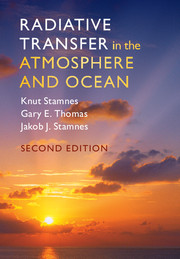Book contents
- Frontmatter
- Contents
- List of Illustrations
- List of Tables
- 1 Basic Properties of Radiation, Atmospheres, and Oceans
- 2 Basic State Variables and the Radiative Transfer Equation
- 3 Basic Scattering Processes
- 4 Absorption by Solid, Aqueous, and Gaseous Media
- 5 Principles of Radiative Transfer
- 6 Formulation of Radiative Transfer Problems
- 7 Approximate Solutions of Prototype Problems
- 8 The Role of Radiation in Climate
- 9 Accurate Numerical Solutions of Prototype Problems
- 10 Shortwave Radiative Transfer in the Atmosphere and Ocean
- Appendix A Nomenclature: Glossary of Symbols
- Appendix B Physical Constants
- Appendix C Ocean Optics Nomenclature
- Appendix D Reflectance and Transmittance at an Interface
- References
- Index
2 - Basic State Variables and the Radiative Transfer Equation
Published online by Cambridge University Press: 13 July 2017
- Frontmatter
- Contents
- List of Illustrations
- List of Tables
- 1 Basic Properties of Radiation, Atmospheres, and Oceans
- 2 Basic State Variables and the Radiative Transfer Equation
- 3 Basic Scattering Processes
- 4 Absorption by Solid, Aqueous, and Gaseous Media
- 5 Principles of Radiative Transfer
- 6 Formulation of Radiative Transfer Problems
- 7 Approximate Solutions of Prototype Problems
- 8 The Role of Radiation in Climate
- 9 Accurate Numerical Solutions of Prototype Problems
- 10 Shortwave Radiative Transfer in the Atmosphere and Ocean
- Appendix A Nomenclature: Glossary of Symbols
- Appendix B Physical Constants
- Appendix C Ocean Optics Nomenclature
- Appendix D Reflectance and Transmittance at an Interface
- References
- Index
Summary
Introduction
In this book, we are mostly concerned with the flow of radiative energy through atmospheres and oceans. We will ignore polarization effects, which means that we disregard the Q, U, and V components of the Stokes vector, and consider only the first, radiance, component denoted by I. This approach is known as the scalar approximation, in contrast to the more accurate vector description. In general, this approximation is valid for longwave radiation where thermal emission and absorption dominate scattering processes. However, at short wavelengths where scattering is important, the radiation is generally partially polarized. For example, polarization is a basic part of a description of scattering of sunlight in a clear atmosphere or in pure water (so-called Rayleigh scattering). Generally, a coupling occurs between the various Stokes components, and an accurate description requires the full Stokes vector representation.
In the scalar approximation the radiance plays as central a role in radiative transfer theory as the wave function does in quantum theory. Its full specification as a function of position, direction, and frequency variables conveys all of the desired information about the radiation field (except for polarization).
In this chapter, we define the basic state variable of the theory, the radiance. We first review the most basic concepts of geometrical optics, those of pencils and beams of light. We then define the various state variables in a transparent medium, involving flow of radiative energy in beams traveling in specific directions and over a hemisphere. Several theorems governing the propagation of the radiance are described. The Extinction Law is stated in both differential and integral forms. The radiative transfer equation is shown to be a consequence of extinction and the existence of radiation sources.
A brief description of our notation is in order. Radiation state variables are described in terms of both spectral (or monochromatic) quantities and frequency-integrated quantities. Frequency is measured in cycles per second or Hertz, abbreviated as [Hz]. For spectral quantities, we may visualize a small frequency interval over which all properties of the radiation and its interaction with matter are constant. A general quantity, is identified with a frequency subscript if it is defined on a per-frequency basis. If f is a function of frequency, it is written.
- Type
- Chapter
- Information
- Radiative Transfer in the Atmosphere and Ocean , pp. 37 - 58Publisher: Cambridge University PressPrint publication year: 2017



